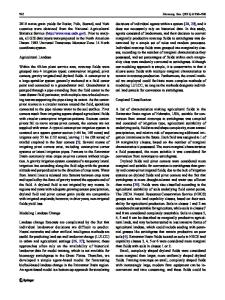Impact of Hot Water and Alkaline Pre-treatments in Cellulosic Ethanol Production from Banana Pseudostem
- PDF / 485,478 Bytes
- 12 Pages / 595.276 x 790.866 pts Page_size
- 103 Downloads / 385 Views
Impact of Hot Water and Alkaline Pre-treatments in Cellulosic Ethanol Production from Banana Pseudostem Isadora Ferreira da Silva 1 & Luciana Reis Fontinelle Souto 2 & Samuel R. A. Collins 3 & Adam Elliston 3 & José Humberto de Queiroz 1 & Keith W. Waldron 3
# Springer Science+Business Media, LLC, part of Springer Nature 2020
Abstract For every 1 tonne of bananas produced, 3 tonnes of pseudostem waste is also created. The aim of this research is to improve the pre-treatment methods used in converting this renewable resource to bioethanol. The microwave-assisted liquid hot water and alkaline with sodium hydroxide were performed on banana pseudostem followed by saccharification and fermentation to ethanol. The liquid hot water pre-treatment was performed over a range of severities (1.88–4.84). The alkaline pre-treatment was carried out to evaluate the effect of NaOH loading (0.09–0.3 g NaOH g−1 dry banana pseudostem) and severity factor (3.65–4.84). The severity factor of 4.84 from the liquid hot water pre-treatment and run 1 (Log Ro 3.65, 0.09 g NaOH g−1 dry banana pseudostem) from the alkaline pre-treatment reached the highest enzymatic hydrolysis yields for each pre-treatment conditions and were chosen to be submitted to fermentation. Subsequently, simultaneous saccharification and fermentation (SSF) at 25 °C for 120 h, using samples from alkaline (Log Ro 3.65, 0.09 g NaOH g−1 dry banana pseudostem) and liquid hot water (Log Ro 4.84) pretreatments, resulted in 92 wt% and 95 wt% of the theoretical ethanol yield respectively, comparing to 60 wt% from the untreated biomass. The liquid hot water is considered a more suitable pre-treatment, as it is more economical and is an environmentally friendly alternative compared to the alkaline pre-treatment. The latter can lead to pollution as the sodium discharge in the process effluent is difficult to recycle and so may limit its application on a commercial scale. Keywords Pre-treatment . Lignocellulosic biomass . Banana Pseudostem . Ethanol production . Simultaneous Saccharification and fermentation
Introduction With the increasing demand for energy and environmental concerns, renewable energy can be considered as an attractive option to replace conventional fossil fuels. Lignocellulosic
Electronic supplementary material The online version of this article (https://doi.org/10.1007/s12155-020-10123-w) contains supplementary material, which is available to authorized users. * Isadora Ferreira da Silva [email protected] 1
Department of Applied Biochemistry, UFV, Vicosa, Minas Gerais 36570-000, Brazil
2
Department of Chemical and Food Engineering, UFSC, Florianopolis, Santa Catarina 88040-900, Brazil
3
Norwich Research Park, Quadram Institute Bioscience, Colney, Norwich NR4 7UA, UK
biomass has been gaining a lot of attention as a sustainable substrate for producing biofuels such as cellulosic ethanol. Brazil has great potential for large-scale biofuels production from biomass due to the abundance of agroforestry biomass in quantity and diversity. Brazilian ag
Data Loading...











